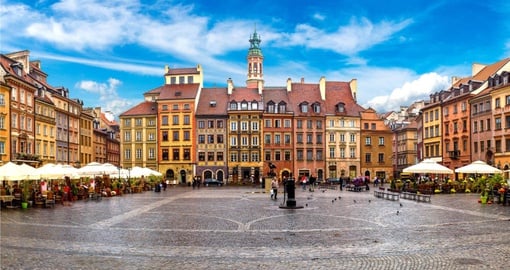Things to do in Warsaw
Palace of Culture and Science
The Palace of Culture and Science building is the embodiment of Socialist Realist architecture. It is still the tallest building in Poland and fulfils the role of a cultural centre accommodating theatres, museums, a cinema and a concert hall. Warsaw's Castle Square is a historic square in front of the Royal Castle, the former official residence of Polish monarchs. It is a popular meeting place for visitors on Poland tours and locals.
The Cathedral
The Cathedral in Warsaw was erected in its present form in the 14th century. In the 17th century, the Gothic church was rebuilt in the Baroque style and at that time, was one of the richest Polish churches, its interior filled with works of art, thanks to the patronage of kings and nobles. The basilica has witnessed many historic events such as coronations.
Royal Castle
Built in the 15th century, the Royal Castle has been renovated repeatedly and was destroyed completely during World War II. Now rebuilt, it serves as a museum. Many official visits and state meetings are also held in the Royal Castle. In the Second World War, a huge part of the castle was damaged in 1939, later in 1944, the remaining parts were destroyed. Today’s Royal Castle is a reconstruction of the old castle. Fortunately, lots of original details can still be seen today as they were kept at a secure location during the war. The Royal Castle has exhibits of works of art and period furniture that can be viewed on a Poland tour together with its halls and salons. These include the Great Apartment and the magnificent Great Assembly Hall, restored in the 18th Century with its gilded stucco and golden columns. The National Hall has six huge canvases depicting scenes from Polish history. Other rooms include the Marble Room with 22 portraits of Polish Kings and King’s Apartment with 23 Italian paintings.
Warsaw Historical Museum
The Warsaw Historical Museum houses various collections in the fields of archaeology, painting, graphics, iconography, sculptures, decorative arts, numismatics and architectural drawings and now exceeds 250,000 objects. The Warsaw Historical Museum was established in 1936 as the Museum of Old Warsaw. The museum, along with its collection, was destroyed during the Warsaw Uprising during World War II. After the war, the museum was reopened under its current name
Warsaw Uprising Monument
Another important site on a Poland vacation is the Memorial to the 1944 Uprising. The Warsaw Uprising is an exceptional chapter in the city’s history, one that is both heroic and tragic. A visit to the Warsaw Uprising Museum is a moving experience and is a tribute to the Warsaw residents who fought and died in their effort to free the city from the Nazi army in 1944. The exhibits depict the fighting and the everyday life of these people. There are 800 exhibit items and 1500 photographs, films, and sound recordings. The stories of those who witnessed the 1944 events are heard on audio recordings, and the movie theatre shows films about the Warsaw Uprising on a panoramic screen.
Madame Curie
Madame Curie’s birthplace and home are worth a visit on Poland tours. This Polish and naturalized-French physicist and chemist conducted pioneering research on radioactivity and became the first woman to win a Nobel Prize and the first person — man or woman — to win the award twice. With her husband Pierre Curie, Marie's efforts led to the discovery of polonium and radium and, after Pierre's death, the further development of X-rays. The famed scientist died in 1934 of aplastic anaemia likely caused by exposure to radiation.
Fryderyk Chopin Museum
The interactive Fryderyk Chopin Museum opened to commemorate the 200th anniversary of the composer's birth. Originally a two-roomed museum with dank gloomy basements in the city's 17th Century Ostrogski Castle, it has been transformed into a five-storey exhibition which makes good use of modern technology to tell the story of one of the greatest pianists in history. Also of interest is his birthplace. Frederick Chopin was born on the estate belonging to Count Skarbek in Zelazowa Wola where his father was a tutor and his mother was a relative of the Count.
Lazienki Park
Lazienki Park is the largest park in Warsaw, occupying 76 hectares of the city centre. The park and palace complex lies in Warsaw's central district. It was designed in the 17th Century in the baroque style. Most of the buildings in the park suffered severe fire damage during and after the 1944 Warsaw Uprising. Reconstruction of the park and palaces was completed within a few years after World War II.
Get a Trip Quote Order a Brochure

















